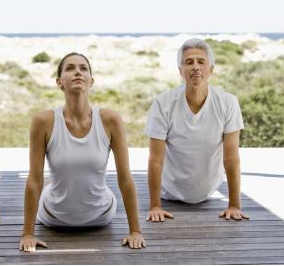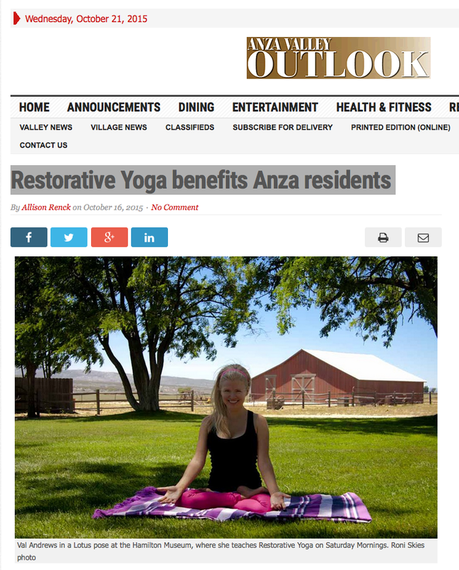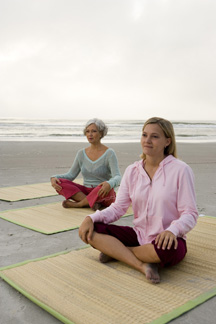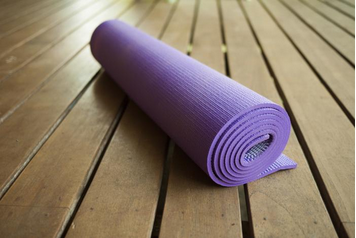|
Benefits of Yin Yoga
By Lyra Radford Courtesy of livestrong.com Stretch and strengthen your joints as well as your muscles. The yin and yang practices of yoga complement each other with their opposing natures. Yin yoga conditions you in a way that allows you to stretch and strengthen as well as achieve the complete relaxation conducive to effective meditation that yang yoga alone cannot help you reach. The benefits of yin yoga are rich for the mind and the body. Stretching Connective Tissue The poses associated with yin yoga primarily stretch and strengthen the joints as well as the surrounding connective tissue as opposed to muscles that are primarily worked in yang yoga. Connective tissue can be found all throughout the body but is concentrated mostly in the joints. Yin yoga supports the stretching and relaxation of the hips, knees and spine, which are not areas most people are mindful of working on. Doing so, however, promotes better circulation as well as flexibility in otherwise inflexible areas of the body. Long, gentle stretches are held for at least three minutes and often longer. Benefits on an Energetic Level The prana, or life force, which is said to reside in the tissues throughout the body often becomes built up. It’s as if the joints and tissues act as a dam to the natural flow of internal energy. Yin yoga poses, which are thought to act similarly as Chinese acupuncture, encourage the release of this blockage. Energy channels referred to as nadis are said to have control over things such as emotional well-being and the immune system. Strengthening these channels is one of the motivations behind many of the poses in yin yoga. Mental Balance Through Meditation Meditation is a way to become in tune with yourself. Doing so is a freeing act and you will eventually develop a heightened sense of comfort and control within yourself. Quieting the mind and body and becoming still for the purpose of knowing your internal ongoings are characteristic of both yin yoga and meditation. Meditating after yin yoga practice is helpful, as you've become mentally prepared by the latter. Yin yoga allows for physical preparation for meditation as well. It works to improve the flow of inner energy and physically opens the hip area, allowing for proper positioning when meditating. Additional Benefits Regarding External Sources Internal balance and harmony affect how one reacts to external forces. With the clarity gained through yin practices and meditation, external stressors take less of a toll on your mental and physical states. The physical and mental training of holding uncomfortable positions for long periods of time translate into endurance in other aspects of daily life. As yin yoga instructor Sarah Powers stated, "It trains you to become more comfortable with discomfort instead of becoming alarmed." You'll have the discipline to better endure either physical or mental discomfort.
1 Comment
Very grateful and honored to have shared Yoga with Aguanga and Anza for the past 8 months and thrilled to want to stay on ‘til our last breaths! Thank you!! ♥!!! It’s been Awesome so far! Hubby and I moved here almost 3 years ago and we’re feeling energized and enthusiastic about this adventure! Yoga has kept us healthy and feeling invigorated for 20+ years and now, we’re over the moon to have given ourselves over to teaching! Call, text or email if you’re interested in the least! ♥!!! The 10AM Hamilton Museum Saturday Restorative classes have been wonderful out on the gorgeous lawn and under the big, old trees! Our students there range from age 10 to 92 and everyone has expressed experiencing major positive changes. YAAYYY! ♥!!! As the weather cools, we’ll move the Saturday morning class over to the very comfy Gregoire Combatives Martial Arts Studio! The cushy tatami mats there makes us all swoon! At that time, we’ll be adding a few new classes! Maybe a kids class, a class for teens, a yoga-for-dudes, an intro-to-yoga and/or a yin class. Please message us with preferred days and times and we’ll do our very best to accommodate! Thank you to everyone who are a part of the current Restorative, Yoga One and private classes! The progress shared is truly joyous and astounding! Here’s to your well-being! Mind and Body! Thank you for the opportunity! ♥!!! Tonight and every Monday night, there’s Restorative Yoga at 6:30pm and a Yoga One class at 7:45pm at Gregoire Combatives. Please join us for a few laughs and a bit of stretching! Happy to take GREAT care of you! All props are provided, classes are 100% secular and cost $10! Unlimited monthly program coming soon! I’ll post any and all updated info, as it’s being scheduled! Thank you again, ALL! ♥!!!! Yours, Val and Roni. From the American Osteopathic Association: The Benefits of Yoga Developed in India thousands of years ago, yoga has become an increasingly popular form of exercise in the United States. Whether yoga’s recent rise in popularity stems from an increase in stress levels or the following of a Hollywood trend, yoga delivers many benefits to those who incorporate it into their everyday lives.
“Yoga is a healing system of theory and practice. The purpose of yoga is to create strength, awareness and harmony in both the mind and body,” explains Natalie Nevins, DO, a board-certified osteopathic family physician and certified Kundalini Yoga instructor in Hollywood, California. “As an osteopathic physician, I focus a lot of my efforts on preventive medicine and practices, and in the body’s ability to heal itself. Yoga is a great tool for staying healthy because it is based on similar principles.” While there are more than one hundred different types, or schools, of yoga, most sessions are typically comprised of breathing exercises, meditation, and assuming postures (sometimes called asana or poses) that stretch and flex various muscle groups. Benefits of Yoga“The relaxation techniques incorporated in yoga can lessen chronic pain, such as lower back pain, arthritis, headaches and carpal tunnel syndrome,” explains Dr. Nevins. “Yoga can also lower blood pressure and reduce insomnia.” According to Dr. Nevins, other physical benefits include:
Unlike more traditional forms of exercise, yoga’s incorporation of meditation and breathing help a person improve his/her mental well-being. “Regular yoga practice creates mental clarity and calmness; increases body awareness; relieves chronic stress patterns; relaxes the mind; centers attention; and sharpens concentration,” says Dr. Nevins. Body and self-awareness, in particular, are very beneficial, adds Dr. Nevins, “because it can help with early detection of physical problems or ailments and allow for early preventive action.” Because there are so many different kinds of yoga practices, it is possible for anyone to start. “Whether you’re a couch potato or a professional athlete, size and fitness levels do not matter because there are modifications for every yoga pose and beginner classes in every style,” says Dr. Nevins. “The idea is to explore your limits, not strive for some pretzel-like perfection.” Yoga can be practiced to enhance overall health, to improve balance, to heal and prevent injuries, to strengthen muscles and to open the body for meditation. “It is a great way to get in tune with your body and your inner self,” says Dr. Nevins. Yoga's increasing popularity is proof that many people value an exercise system that engages the mind, body and spirit in equal measure. If you've never done yoga before, give it a try and see what it can do for you. Yogis with arthritis had better physical health, less joint pain and less depression
Exercise works all kinds of wonders on the human body, from stabilizing joints to improving muscle mass to reducing inflammation. That’s pretty motivating when your body feels good—but less so when it aches. 44% of people with arthritis say they don’t exercise, and close to 80% aren’t active enough. But a recent randomized controlled trial published in the Journal of Rheumatology finds that people with arthritis who practice yoga can reap impressive physical and mental benefits. Those who practiced yoga three times a week had an improvement in pain levels, energy, mood and physical health compared to the group that didn’t do yoga—and the effects lasted even nine months later. “There’s kind of a myth that says if you have arthritis, the good thing to do is to rest your joints,” says one of the study’s authors Dr. Clifton O. Bingham III, associate professor of medicine at Johns Hopkins University School of Medicine and director of the Johns Hopkins Arthritis Center. “I think the study is more evidence that, in fact, that’s not true.” In the trial, the researchers recruited 75 adults who didn’t exercise and had rheumatoid arthritis, a condition that affects the body’s smaller joints like the wrists, feet and ankles, or knee osteoarthritis, which is localized to the knee. One group practiced a specialized kind of yoga for eight weeks: group classes modified by arthritis experts to take the stress off of joints. Each hour-long class took place twice a week, and the people in the group were told to do a weekly class at home. The other group exercised as usual. After eight weeks, the people in the yoga group saw improvement across all measures compared to the control group. Their physical health, flexibility, pain levels, walking capacity and depression scores were better. The benefits lasted nine months later, when researchers checked up on them again. Some of the people in the yoga group are Bingham’s patients and still doing yoga five-plus years later, he says. “It really has been transformative for a lot of my patients,” he says. “What [one patient] learned from the yoga experience was the philosophy of non-harming and the idea that where she is today is good enough,” Bingham says. “Those types of things are very difficult to measure in terms of an outcome from a study, but we certainly saw them on a real one-on-one patient level.” Not every yoga class is safe for people with arthritis, Bingham says, and he advises people to consult with their arthritis specialist before starting. It’s important to also ask the yoga teacher if they have experience dealing with the disability, he says. Gentle yoga, prenatal yoga or classes designed for an older or disabled population are good places to start. The results of the study suggest that gentle yoga can be a safe practice for people with arthritis, and that it doesn’t make symptoms worse—in fact, quite the opposite.
|
AuthorYOGA SKIES Archives
January 2020
Categories |




 RSS Feed
RSS Feed